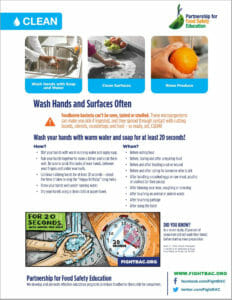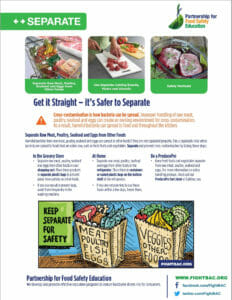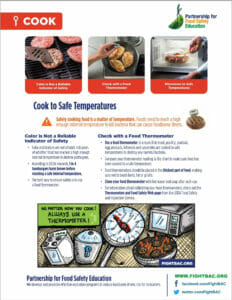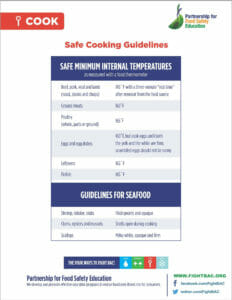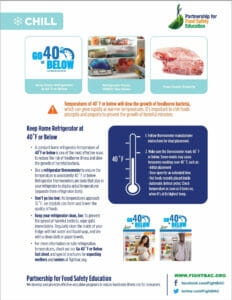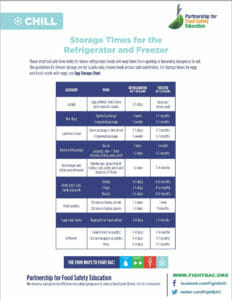About the Core Four Practices
Right now, there may be an invisible enemy ready to strike. He’s called BAC (bacteria) and he can make people sick. In fact, even though consumers can’t see BAC – or smell him, or feel him – he and millions more like him may already be invading food products, kitchen surfaces, knives and other utensils. But you have the power to Fight BAC!® and to reduce your risk of foodborne illness. It’s as easy as following these core four Fight BAC!® practices for food safety:
Core Four Practice: Clean
Wash hands and surfaces often
Bacteria can be spread throughout the kitchen and get onto hands, cutting boards, utensils, counter tops and food. To Fight BAC!® always use food safety practices:
- Wash your hands with warm water and soap for at least 20 seconds before and after handling food and after using the bathroom, changing diapers and handling pets.
- Wash your cutting boards, dishes, utensils, and counter tops with hot soapy water after preparing each food item and before you go on to the next food.
- Consider using paper towels to clean up kitchen surfaces. If you use cloth towels wash them often in the hot cycle of your washing machine.
- Rinse fresh fruits and vegetables under running tap water, including those with skins and rinds that are not eaten.
- Rub firm-skinned fruits and vegetables under running tap water or scrub with a clean vegetable brush while rinsing with running tap water.
Core Four Practice: Separate
Don’t cross-contaminate
Cross-contamination is how bacteria can be spread. Improper handling of raw meat, poultry, seafood and eggs can create an inviting environment for cross-contamination. As a result harmful bacteria can spread to food and throughout the kitchen leading to a foodborne illness.
- Separate raw meat, poultry, seafood and eggs from other foods in your grocery shopping cart, grocery bags and in your refrigerator.
- Use one cutting board for fresh produce and a separate one for raw meat, poultry and seafood.
- Never place cooked food on a plate that previously held raw meat, poultry, seafood or eggs.
Core Four Practice: Cook
Cook to the safe internal temperature
Food is safely cooked when it reaches a high enough internal temperature to kill the harmful bacteria that cause foodborne illness. Use a food thermometer to measure the internal temperature of cooked foods. The best way to Fight BAC!® is to:
- Use a food thermometer which measures the internal temperature of cooked meat, poultry and egg dishes, to make sure that the food is cooked to a safe internal temperature.
- Cook roasts and steaks to a minimum of 145 °F. All poultry should reach a safe minimum internal temperature of 165 °F as measured with a food thermometer. Check the internal temperature in the innermost part of the thigh and wing and the thickest part of the breast with a food thermometer.
- Cook ground meat, where bacteria can spread during grinding, to at least 160 °F. Information from the Centers for Disease Control and Prevention (CDC) links eating undercooked ground beef with a higher risk of illness. Remember, color is not a reliable indicator of doneness. Use a food thermometer to check the internal temperature of your burgers.
- Cook eggs and dishes containing eggs until the internal temperature reaches 160 °F on a food thermometer.
- Cook eggs until the yolk and white are firm, not runny. Don’t use recipes in which eggs remain raw or only partially cooked.
- Cook fish to 145 °F or until the flesh is opaque and separates easily with a fork.
- Make sure there are no cold spots in food (where bacteria can survive) when cooking in a microwave oven. For best results, cover food, stir and rotate for even cooking. If there is no turntable, rotate the dish by hand once or twice during cooking.
- Bring sauces, soups and gravy to a boil when reheating. Heat other leftovers thoroughly to 165 °F.
Core Four Practice: Chill
Refrigerate promptly
Check out the 40 or Below campaign
Refrigerate foods quickly because cold temperatures slow the growth of harmful bacteria. Do not over-stuff the refrigerator. Cold air must circulate to help keep food safe. Keeping a constant refrigerator temperature of 40 °F or below is one of the most effective ways to reduce the risk of foodborne illness. Use an appliance thermometer to be sure the temperature is consistently 40 °F or below. The freezer temperature should be 0 °F or below.
- Refrigerate or freeze meat, poultry, eggs and other perishables as soon as you get them home from the store.
- Never let raw meat, poultry, eggs, cooked food or cut fresh fruits or vegetables sit at room temperature more than two hours before putting them in the refrigerator or freezer (one hour when the temperature is above 90 °F).
- Never thaw food at room temperature. Food must be kept at a safe temperature during thawing. There are three safe ways to thaw food: (1) in the refrigerator, (2) in cold water, and (3) in the microwave. Food thawed in cold water or in the microwave should be cooked immediately.
- Always marinate food in the refrigerator.
- Divide large amounts of leftovers into shallow containers for quicker cooling in the refrigerator.
- Use or discard refrigerated food on a regular basis.

